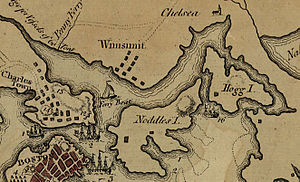Battle of Chelsea Creek
| Battle of Chelsea Creek | |||||||
|---|---|---|---|---|---|---|---|
| Part of the American Revolutionary War | |||||||
 Map of the battle location. Chelsea Creek separated the islands from Chelsea on the mainland to the north. The schooner Diana is represented by the burning vessel labeled "16". It was in Chelsea Creek during the battle and was never at the location indicated. It burned north of the boat labeled "Ferry Boat." |
|||||||
|
|||||||
| Belligerents | |||||||
|
|
|
||||||
| Commanders and leaders | |||||||
|
|
|
||||||
| Strength | |||||||
| Several hundred Royal Marines (Samuel Graves). 30 on the Diana (Thomas Graves). These are rough estimates. | 300–600 in initial force to Hog Island (Stark). 300 additional reinforcements during the course of the battle (Putnam). These are rough estimates. | ||||||
| Casualties and losses | |||||||
| 2 killed, several wounded, Armed schooner Diana destroyed |
4 wounded | ||||||
The Battle of Chelsea Creek was the second military engagement of the Boston campaign of the American Revolutionary War. It is also known as the Battle of Noddle's Island, Battle of Hog Island and the Battle of the Chelsea Estuary. This battle was fought on May 27 and 28, 1775, on Chelsea Creek and on salt marshes, mudflats, and islands of Boston Harbor, northeast of the Boston peninsula. Most of these areas have since been united with the mainland by land reclamation and are now part of East Boston, Chelsea, Winthrop, and Revere.
The American colonists met their goal of strengthening the siege of Boston by removing livestock and hay on those islands from the reach of the British regulars. The British armed schooner Diana was also destroyed and its weaponry was appropriated by the Colonial side. This was the first naval capture of the war, and it was a significant boost to the morale of the Colonial forces.
...
Wikipedia
